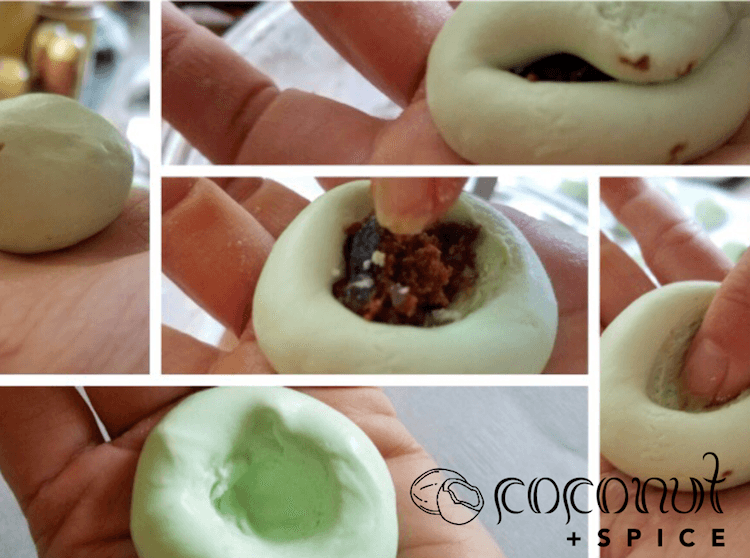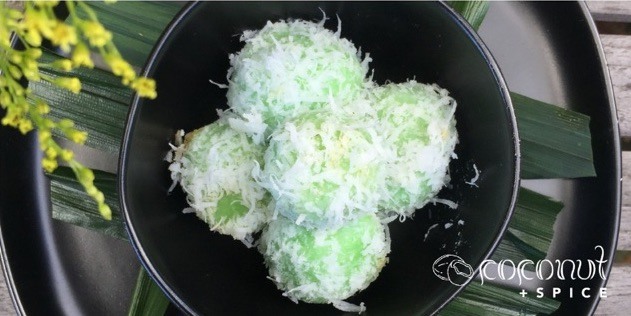Klepon was definitely one of my favorite sweet Indonesian snacks growing up. Often served with afternoon tea, these green little bite-size balls, coated in freshly grated coconut usually come in a foursome and are loosely packed in a mini shallow box made of banana leaves.
There is a simple technique on how to eat them. You pop one in, close your mouth, slowly take a bite into the chewy outer part
Inside, comes a surprise in a form of sweet, nutty melted gula
COULD SOMETHING THIS DAINTY AND DELICIOUS BE EASY TO MAKE?
I never thought I would ever attempt to make this, it seems too labor intensive and complicated, but I decided to give this a try after my dad suggested while we were skyping one night. What a great idea, especially since I had just purchased a coconut for
After I started going through my Indo cookbooks and google search (My mom provided no help on this), I discovered how simple it is to make
True, most likely they are not stocked in your average pantry, but they are readily available in any Asian grocery stores and not surprisingly, Amazon.
My only regret is I wish I knew this decades ago. I could’ve made
COCONUT VERSATILITY IN INDONESIAN COOKING
In the western world coconut products such as coconut water, coconut milk and coconut oil started to gain its popularity because of some of the health benefits. But in Indonesia where there is no shortage of coconut trees, they have always been so integrated in the people’s everyday life because of its versatility:
- The leaves are used for traditional ceremonial decorations in Balinese culture (janur). They are also excellent for basket making and ketupat holder (rice cake steamed in a square-shape container made by weaving coconut leaves).
- The water which is high in potassium, not only makes a nice refreshing drink, it is also good for brining chicken before going to the fryer.
- The young coconut flesh is delicious for eating and often found itself in a lot of Indonesian sweet drinks such as es teler (a combination of young coconut, avocado and sometimes jackfruit in lightly sweetened coconut water served over ice cubes/shaved ice).
- The mature flesh is often grated to make coconut milk/cream for a variety of dishes. Grated coconut also found itself in a lot of Indo dishes, including Klepon.
- The husk is often used to start a fire in a traditional kitchen.
- The shell can be made into spoon, bowl, home decoration, even backsplash.
- The trunk can be turned into furniture and building blocks in traditional houses
GULA JAWA
One of the most important ingredients in this sweet snack is gula
Usually comes in a cylinder shape, it is moist and crumbly in texture. To use, you will need to shave off pieces needed with a knife
Try not to substitute with other sugar because of its distinct flavor. Gula
PREPARATION
STEP #1
The first step is to grate coconut flesh from ½ of a coconut with a microplane. You should have about 1 cup. Sprinkle a pinch of salt, toss lightly and set aside.
STEP #2
The second step is to make the dumpling. In a small pot, combine coconut cream and a pinch of salt with water and place over medium heat until warm to the touch
Add about 4 drops of pandan extract and set aside. Measure 1 ½ cup of glutinous rice flour in a
Add warm coconut mixture. Using a wooden spoon, stir until dough comes together and pull away from the bowl. The dough should be matte and pliable.

Take a spoonful into your palm and test if it is rollable. If too sticky, sprinkle a little glutinous rice flour and give a little
Take about 1 tsp of dough and roll in your palms to form a ball about 1 inch in diameter. Using your index finger, press a hole in the center and place about 1/8 tsp of gula
Slowly close dough around the hole, making sure sugar is tucked neatly inside. Roll until a nice smooth ball is formed. Continue making these little balls until dough is gone.
You should have about 2 dozen balls.

STEP #3
The third step is to poach dumplings. Bring water to a boil in a medium size pot. Slowly put dumplings in boiling water to avoid splashing
Be sure not to overcrowd
Serve warm or in room temperature. I advise against refrigerating
Klepon / Onde Onde

Glutinous rice dumpling, filled with melted gula jawa (Indonesian coconut palm sugar), rolled in freshly shredded coconut
Ingredients
- 1 cup freshly grated coconut (from ½ coconut)
- A pinch of salt
- 1 ½ cup glutinous rice flour
- ½ cup of coconut cream (I use Savoy brand)
- ¼ cup of water
- 4 drops of pandan extract
- ¼ cup gula jawa, shaved
- A pinch of salt
Instructions
1. Grate fresh coconut with a microplane. Sprinkle a pinch of salt, toss lightly and set aside.
2. In a small pot, combine coconut cream and a pinch of salt with water, place over medium heat until warm to the touch. Remove from heat. Put 4 drops of pandan extract, stir and set aside.
3. In a separate medium size pot, bring water to a boil.
4. While the pot of water is heating up, combine glutinous rice flour and coconut mixture in a mixing bowl. Using a wooden spoon, stir until dough comes together and pulled away from bowl. Dough should be matte and pliable. If dough is too sticky to roll, sprinkle a little glutinous rice flour and knead
5. Take about 1 tsp of dough and roll in your palms to form a ball about 1 inch in diameter. Using an index finger, press a hole in the middle. Place about 1/8 tsp of gula jawa in the center of hole then slowly closing dough around the hole, making sure sugar is nicely tucked inside. Roll until a nice smooth ball is formed. Continue until all dough is gone.
6. Place balls in boiling water slowly. Be sure not to overcrowd pot. Dumplings are ready when they float to surface. Remove with a strainer spoon and immediately roll them in shredded coconut to coat. Continue until all dumplings are gone.
7. Enjoy while still warm or at room temperature.

